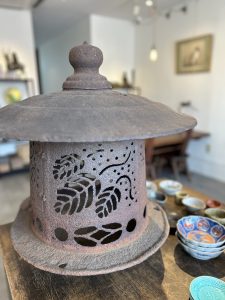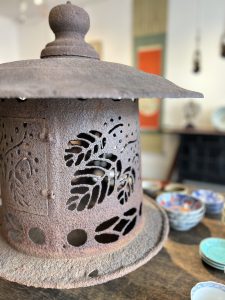長年勘違いしておりました(愛知県名古屋市千種区姫池通 骨董買取 古美術風光舎)
2024.03.06
皆さまこんにちは。スタッフHでございます。
寒暖差の激しいこの冬、頭では上手く対処できているつもりでも、体がついていけないこともございます。辛い時には無理をせず暖かくしてお過ごしください。
今朝、通りすがりにお庭に置かれた立派な燈籠を目にし、改めて風光舎の鉄製の燈籠を眺めております。店の真ん中でどっしりとした存在感を放っていおります雪見燈籠。透かし模様は桐の葉のようにも見えますが、鉄製のため洋風のデザインにも見えます。火が灯され模様が美しく浮き上がる姿もいつか見てみたいものです。
燈籠といえば御影石など石でできたものが多く鉄製のものは少ないようです。作られた当初は恐らく鈍い光を放っていたと思われますが、今の錆びた様子も年月の流れを感じ味わいがあります。
燈籠には「春日型」「織部型」など様々な種類がありますが、「雪見灯籠」の特徴は笠の部分が大きく、丸型と六角形が主流で「丸雪見」「六角雪見」と呼ばれています。基礎の部分は3つ足が4つ足が一般的とのこと。
名前の由来については、「笠の部分が雪が積もったように見える」「笠に積もった雪を鑑賞して楽しむ」などの説もあるようですが、有力な説としては滋賀県の近江八景にある「浮御堂(うきみどう)」に似ているからとのことです。「うきみ」が「ゆきみ」に変化したと言われています。主に水面を照らすために笠の部分が大きく、水際に設置されることが多いそうです。
燈籠は古くから東アジアの伝統的な照明器具として利用され、日本には奈良時代に仏教の伝来とともに伝わりました。仏教では灯が邪気を払うとされております。また故人があの世で迷子にならないように道しるべとなるよう灯を用いたとされています。日本全国で行われる「灯籠流し」や「灯籠まつり」は供養や鎮魂を目的として古くから行われてきました。
日本庭園に燈籠が取り入れられたのは桃山時代に広がった茶道文化の影響とされています。夕暮れ時の茶会における庭のあかりとして茶庭に取り入れられました。月明りのみが頼りの中、優しい燈籠の灯が路地を行く人の足元を照らしていたことでしょう。
今となっては電気がない生活を送ることは想像できませんが、昔の人々も漆黒の夜に明かりを求めて試行錯誤していたようです。数万年前には動物からとった油を、そして3000年前には植物の油を燃やすオイルランプが使われ始めたとのこと。
日本では平安時代に室内で小さな皿に油を満たし、台座にのせて火をともす「灯台(とうだい)」と呼ばれるものが使われていたとか。灯台?と聞いて思い浮かぶのはあの岬の先にある「灯台」でしたので、調べたところ。「灯台下くらし」ということわざの灯台は岬にある灯台ではなく、昔の室内照明の灯台だという事実に行きつきました。私は岬の灯台だと完全に勘違いしておりました。このことわざは江戸時代から存在し、岬にある灯台が「灯台」と呼ばれるのは明治に入ってからで、それまでは「燈明台」と呼ばれていたなどの理由があるそうです。
高い台の上に置かれた皿に油が入っており、真下は皿の陰になって暗かったことから、世間のことをよく知っている人でも身近なことに疎いことや、探していた答えが目の前にあったことなどを意味することわざができたとか。
燈籠について調べていましたら、長年の勘違いに行きつきました。これからは「灯台下くらしだね」と言う時に、あの岬の灯台ではなく、平安時代の室内をほのかに照らす灯台を思い起こすのかと思うと、少し不思議な気もいたします。
それでは、また次の機会に。
Hello everyone. This is Staff H.
This winter, with its extreme differences in temperature, even if you think you are coping well in your head, your body may not be able to keep up with the change. Please take it easy and stay warm when you are having a hard time.
This morning, as I was passing by, I saw a magnificent lantern placed in the garden and took another look at the iron lanterns at Fukosha. The Yukimi Lantern stands with a strong presence in the center of the store. The openwork pattern looks like paulownia leaves, but because it is made of iron, it also looks like a Western design. It would be nice to see the pattern beautifully floating in the air when the lantern is lit.
Most lanterns are made of stone, such as granite, and few are made of iron. When they were first made, they probably emitted a dull light, but the rusted appearance of today’s lanterns is also tasteful, showing the passage of time.
There are various types of lanterns, such as “Kasuga type” and “Oribe type,” but “Yukimi Toro” is characterized by its large shade part, which is usually round or hexagonal, and is called “Maru Yukimi” or “Hexagonal Yukimi. The foundation part is generally three-legged with four legs.
As for the origin of the name, there are some theories, such as “the shade looks like snow piled up” or “people enjoy appreciating the snow piled up on the shade,” but a leading theory is that it is because it resembles “Ukimi-do” in the eight scenic spots of Omi in Shiga Prefecture. It is said that “ukiimi” changed to “yukimi. Lanterns are often placed near the water’s edge with large shades, mainly to illuminate the water’s surface.
Lanterns have long been used as traditional lighting fixtures in East Asia, and were introduced to Japan in the Nara period (710-794) with the arrival of Buddhism. In Buddhism, it is believed that lanterns ward off evil spirits. Lanterns are also believed to have been used to guide the deceased so that they would not get lost in the afterlife. Lantern Floating Ceremonies and Lantern Festivals have been held throughout Japan for the purpose of memorial services and the repose of souls since ancient times.
It is believed that the introduction of lanterns into Japanese gardens was influenced by the tea ceremony culture that spread during the Momoyama period (1573-1600). Lanterns were incorporated into tea gardens to illuminate the garden during tea ceremonies at dusk. With moonlight as the only light, the gentle glow of the lanterns would have illuminated the feet of people walking down the alley.
It is hard to imagine living without electricity today, but it seems that people in the past also tried to find light in the pitch black night. Tens of thousands of years ago, oil from animals was used, and 3,000 years ago, oil lamps burning plant oil began to be used.
In Japan, during the Heian period (794-1185), a small dish filled with oil was placed on a pedestal and lit indoors, called a “todai,” or lighthouse. A lighthouse? When I heard the word “lighthouse,” what came to mind was the “lighthouse” at the end of the cape, so I looked it up. I came across the fact that the lighthouse referred to in the saying “living under the lighthouse” was not a lighthouse on the cape, but an old indoor lighthouse. I had completely misunderstood that it was a lighthouse on the cape. This proverb has existed since the Edo period, and lighthouses on the cape were not called “lighthouses” until the Meiji period (1868-1912), and until then they were called “toromyo-dai” (lighthouse tower), among other reasons.
The oil was in a dish placed on a high pedestal, and directly below was dark in the shadow of the dish, thus creating a proverb meaning that even those who know much about the world are unfamiliar with familiar things, and that the answer they were looking for was right in front of them.
When I was researching about the lighthouse, I came across a longstanding misunderstanding. It is a little strange to think that from now on, when we say, “I live under a lighthouse,” we are not thinking of the lighthouse on the cape, but of the lighthouse that faintly illuminated the room in the Heian period.
See you next time.
*******************
ご実家の整理やお片付けなどをされている方のご相談などが多くございます。
お片付けなどくれぐれもご無理のないようになさってくださいませ。
風光舎では古美術品や骨董品の他にも絵画や宝石、趣味のお品など様々なジャンルのものを買取しております。
お片付けをされていて、こういうものでもいいのかしらと迷われているものでも、どうぞお気軽にご相談下さいませ。
また風光舎は、出張買取も強化しております。ご近所はもちろん、愛知県内、岐阜県、三重県その他の県へも出張いたします。
まずは、お電話お待ちしております。
愛知県名古屋市千種区姫池通
骨董 買取【古美術 風光舎 名古屋店】
TEL052(734)8444
10:00-18:00 OPEN
#骨董買取#古美術買取#出張買取#無料査定#生前整理#遺品整理#家じまい#実家じまい#掛け軸#絵画#木箱入り茶碗#刀剣#洋食器#貴金属



